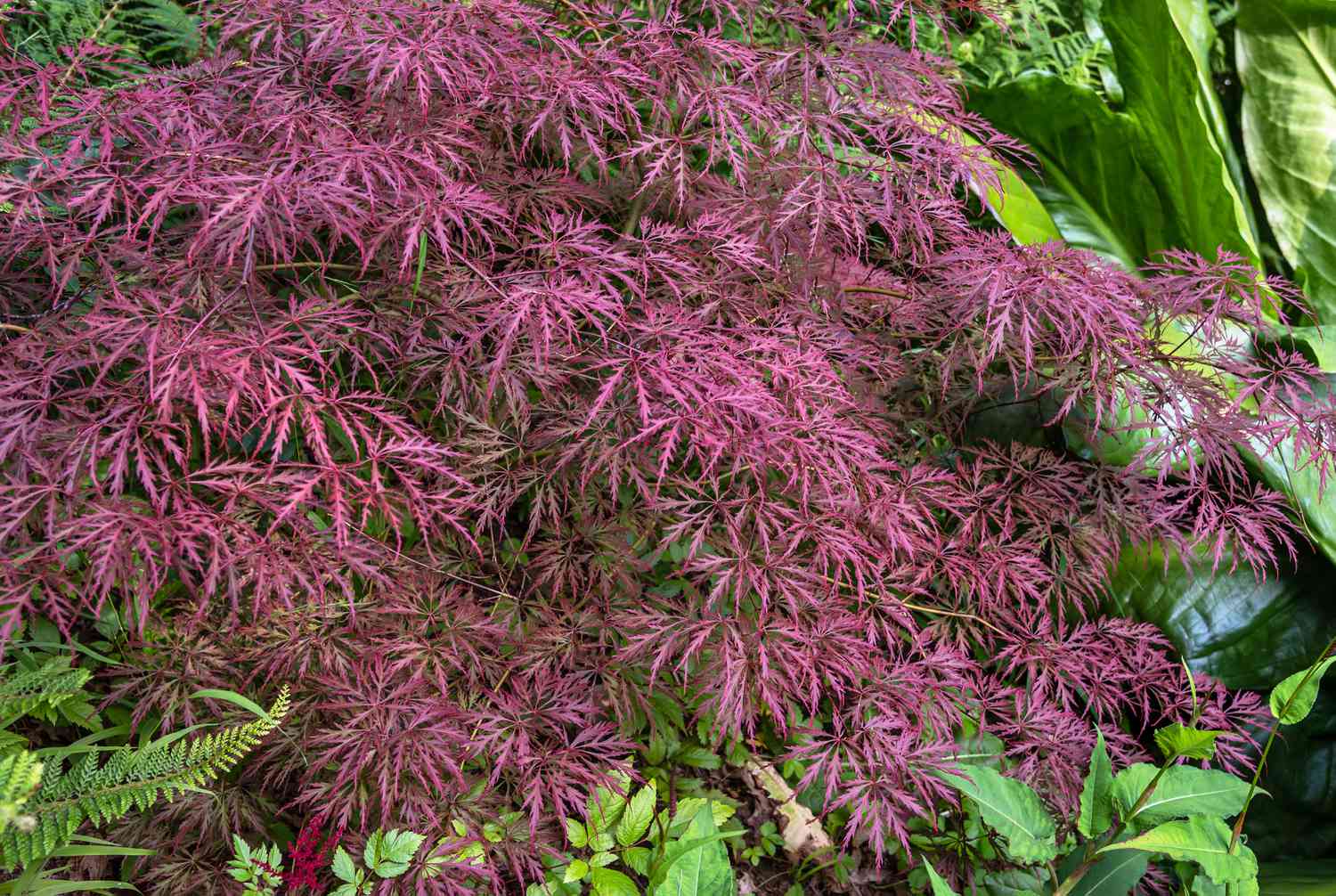
The Japanese Maple, scientifically known as Acer palmatum, is a stunningly beautiful and highly sought-after tree that has captivated plant enthusiasts worldwide. With its delicate leaves, graceful branches, and vibrant colors, the Japanese Maple has become a symbol of elegance and tranquility in gardens and landscapes. This remarkable tree, native to Japan, is renowned for its incredible diversity, with over 1,000 cultivars available, each offering its own unique characteristics and visual appeal.
But the allure of the Japanese Maple extends far beyond its aesthetics. This remarkable tree is also steeped in history and revered for its cultural significance. From its ability to change color with the seasons to its association with Japanese art and architecture, the Japanese Maple is truly a tree that fascinates and captivates. In this article, we will delve into 14 unbelievable facts about the Japanese Maple, shedding light on its remarkable traits, intriguing history, and the secrets behind its enduring popularity.
Key Takeaways:
- Japanese Maple trees come in a wide variety of colors and leaf shapes, making them a stunning addition to any garden. From vibrant reds to delicate lacy foliage, there’s a Japanese Maple for every taste and garden aesthetic.
- Japanese Maple trees can live for over 100 years with proper care, becoming cherished heirlooms in landscapes and gardens. Their ability to change colors throughout the seasons and adapt to various soil conditions makes them a low-maintenance and captivating choice for home gardens.
Japanese Maple trees come in a wide variety of colors and leaf shapes.
One of the most remarkable qualities of the Japanese Maple is its stunning array of colors and leaf shapes. From the vibrant reds and oranges of the Bloodgood variety to the delicate lacy foliage of the Filigree cultivar, there is a Japanese Maple to suit every taste and garden aesthetic.
Japanese Maple trees can live for over 100 years.
These magnificent trees are known for their longevity. With proper care and maintenance, Japanese Maples can thrive for well over a century, becoming cherished heirlooms in landscapes and gardens.
The botanical name for the Japanese Maple is Acer palmatum.
Acer palmatum, commonly known as the Japanese Maple, is a species of deciduous shrub or small tree native to Japan, China, and Korea. It belongs to the Aceraceae family and is renowned for its elegant beauty.
Japanese Maple leaves change color in response to temperature and sunlight.
One of the most enchanting features of Japanese Maples is their ability to change colors throughout the seasons. The leaves may start off green in spring, transition to vibrant reds, yellows, and oranges in autumn, and then fall off in winter, revealing the intricate branches of the tree.
Japanese Maple trees are highly prized in Japanese culture.
In Japanese culture, the Japanese Maple holds significant symbolism and is associated with grace, beauty, and tranquility. It is often featured in Japanese gardens as a focal point or used in bonsai cultivation.
Bonsai enthusiasts adore Japanese Maple trees.
The delicate and intricate foliage of Japanese Maples make them ideal candidates for bonsai cultivation. Their small size, fascinating branching patterns, and vibrant colors make them highly sought after in the bonsai community.
Japanese Maples thrive in partial shade.
While they can tolerate full sun in cooler climates, Japanese Maples prefer and thrive in partial shade. Placing them in a location with dappled sunlight or afternoon shade will help prevent leaf burn and keep the tree healthy and vibrant.
Japanese Maple trees have delicate and intricate branching patterns.
The branches of Japanese Maples form intricate patterns that add to their overall beauty. The delicate nature of the branches adds to their appeal, making them stand out as one of the most distinctive tree species.
Japanese Maple trees are often used in landscaping for their ornamental value.
Due to their striking appearance, Japanese Maples are commonly used in landscaping projects to add beauty, elegance, and color to gardens, parks, and residential areas. Their unique characteristics make them prominent features in both traditional and modern gardens.
Some Japanese Maple varieties can be grown indoors as houseplants.
While they are typically outdoor trees, certain dwarf Japanese Maple varieties can thrive indoors as houseplants. With proper care and attention to lighting and watering needs, these miniature versions can bring a touch of nature to any indoor space.
Japanese Maple trees are relatively low-maintenance.
Japanese Maples are generally easy to care for, requiring moderate watering, occasional pruning to maintain shape, and protection from harsh winds. With their ability to adapt to various soil conditions, they make an excellent choice for home gardens.
Japanese Maple leaves can vary in shape, from palmate to dissectum.
The leaves of Japanese Maples exhibit a fascinating range of shapes. Some have palmate leaves, which resemble the shape of a hand with lobes radiating from the center, while others have dissectum leaves, which are deeply cut and lacy in appearance.
Japanese Maples can be propagated from seeds, cuttings, or grafting.
If you’re interested in growing your own Japanese Maple, you have multiple options for propagation. You can start from seeds, take cuttings from existing trees, or perform grafting techniques to combine desirable characteristics from different varieties.
Japanese Maples are adaptable to containers and make stunning patio trees.
With their compact size and breathtaking foliage, Japanese Maples can be successfully grown in containers. Placing them on patios or balconies allows individuals living in apartments or urban areas to enjoy the beauty of these trees, even with limited space.
Conclusion
The Japanese Maple is truly a remarkable tree, filled with beauty, history, and symbolism. Its distinct features and vibrant colors make it a highly sought-after addition to any garden or landscape. Whether you are a plant enthusiast or simply appreciate nature’s wonders, the Japanese Maple’s unique characteristics are sure to captivate your attention and leave you in awe. From its delicate leaves and graceful branches to its fascinating growth patterns, this tree is a true testament to the beauty and diversity of the plant kingdom.
FAQs
1. How tall does a Japanese Maple tree grow?
Japanese Maple trees typically grow to a height of 10 to 25 feet, depending on the specific cultivar and growing conditions.
2. What is the best time to prune a Japanese Maple?
It is best to prune a Japanese Maple tree during late winter or early spring, before new growth begins. This allows the tree to heal properly and minimizes the risk of disease or pest infestation.
3. Are Japanese Maple trees hard to grow?
While Japanese Maple trees have specific care requirements, they are generally considered moderately easy to grow. With proper soil conditions, regular watering, and protection from extreme temperatures, they can thrive in various climates.
4. Can a Japanese Maple tree be grown in a container?
Yes, Japanese Maple trees can be successfully grown in containers. However, it is important to choose a suitable container with proper drainage and provide regular care to ensure the tree’s health and vitality.
5. Are Japanese Maple leaves always red?
No, Japanese Maple leaves can come in a range of colors, including red, green, purple, and variegated combinations. The color of the leaves can also change throughout the seasons, adding to the tree’s visual appeal.
Captivated by Japanese Maples' stunning beauty and fascinating facts? Continue your exploration with our article on even more incredible truths about these enchanting trees. From their ability to thrive in various climates to the symbolic meanings behind their vibrant colors, there's still so much to learn. Uncover the secrets behind Japanese Maples' popularity among gardeners and enthusiasts alike, and find out how you can incorporate these living works of art into your own landscape. Dive deeper into the world of Japanese Maples and expand your knowledge of these truly remarkable trees!
Was this page helpful?
Our commitment to delivering trustworthy and engaging content is at the heart of what we do. Each fact on our site is contributed by real users like you, bringing a wealth of diverse insights and information. To ensure the highest standards of accuracy and reliability, our dedicated editors meticulously review each submission. This process guarantees that the facts we share are not only fascinating but also credible. Trust in our commitment to quality and authenticity as you explore and learn with us.


